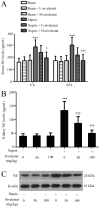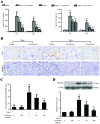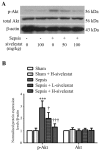The neutrophil elastase inhibitor, sivelestat, attenuates sepsis-related kidney injury in rats
- PMID: 27430552
- PMCID: PMC4990314
- DOI: 10.3892/ijmm.2016.2665
The neutrophil elastase inhibitor, sivelestat, attenuates sepsis-related kidney injury in rats
Abstract
Sepsis-induced acute kidney injury (AKI) represents a major cause of mortality in intensive care units. Sivelestat, a selective inhibitor of neutrophil elastase (NE), can attenuate sepsis-related acute lung injury. However, whether sivelestat can preserve kidney function during sepsis remains unclear. In this study, we thus examined the effects of sivelestat on sepsis-related AKI. Cecal ligation and puncture (CLP) was performed to induce multiple bacterial infection in male Sprague-Dawley rats, and subsequently, 50 or 100 mg/kg sivelestat were administered by intraperitoneal injection immediately after the surgical procedure. In the untreated rats with sepsis, the mean arterial pressure (MAP) and glomerular filtration rate (GFR) were decreased, whereas serum blood urea nitrogen (BUN) and neutrophil gelatinase-associated lipocalin (NGAL) levels were increased. We found that sivelestat promoted the survival of the rats with sepsis, restored the impairment of MAP and GFR, and inhibited the increased BUN and NGAL levels; specifically, the higher dose was more effective. In addition, sivelestat suppressed the CLP-induced macrophage infiltration, the overproduction of pro-inflammatory mediators (tumor necrosis factor‑α, interleukin-1β, high-mobility group box 1 and inducible nitric oxide synthase) and serine/threonine kinase (Akt) pathway activation in the rats. Collectively, our data suggest that the inhibition of NE activity with the inhibitor, sivelestat, is beneficial in ameliorating sepsis-related kidney injury.
Figures





Similar articles
-
A neutrophil elastase inhibitor, sivelestat, reduces lung injury following endotoxin-induced shock in rats by inhibiting HMGB1.Inflammation. 2008 Aug;31(4):227-34. doi: 10.1007/s10753-008-9069-z. Inflammation. 2008. PMID: 18536984
-
Neutrophil elastase inhibitor (sivelestat) attenuates subsequent ventilator-induced lung injury in mice.Eur J Pharmacol. 2007 Sep 24;571(1):62-71. doi: 10.1016/j.ejphar.2007.05.053. Epub 2007 Jun 9. Eur J Pharmacol. 2007. PMID: 17599828
-
Neutrophil elastase inhibitor improves survival of rats with clinically relevant sepsis.Shock. 2010 May;33(5):526-31. doi: 10.1097/SHK.0b013e3181cc064b. Shock. 2010. PMID: 19953005
-
[Pharmacological profile of a specific neutrophil elastase inhibitor, Sivelestat sodium hydrate].Nihon Yakurigaku Zasshi. 2003 Aug;122(2):151-60. doi: 10.1254/fpj.122.151. Nihon Yakurigaku Zasshi. 2003. PMID: 12890901 Review. Japanese.
-
Neutrophil elastase inhibitor (sivelestat) may be a promising therapeutic option for management of acute lung injury/acute respiratory distress syndrome or disseminated intravascular coagulation in COVID-19.J Clin Pharm Ther. 2020 Dec;45(6):1515-1519. doi: 10.1111/jcpt.13251. Epub 2020 Aug 28. J Clin Pharm Ther. 2020. PMID: 32860252 Review.
Cited by
-
The Potential Importance of CXCL1 in the Physiological State and in Noncancer Diseases of the Cardiovascular System, Respiratory System and Skin.Int J Mol Sci. 2022 Dec 22;24(1):205. doi: 10.3390/ijms24010205. Int J Mol Sci. 2022. PMID: 36613652 Free PMC article. Review.
-
Role of using two-route ulinastatin injection to alleviate intestinal injury in septic rats.Chin J Traumatol. 2018 Dec;21(6):323-328. doi: 10.1016/j.cjtee.2018.05.002. Epub 2018 Nov 27. Chin J Traumatol. 2018. PMID: 30591258 Free PMC article.
-
Mechanisms of haemolysis-induced kidney injury.Nat Rev Nephrol. 2019 Nov;15(11):671-692. doi: 10.1038/s41581-019-0181-0. Epub 2019 Aug 27. Nat Rev Nephrol. 2019. PMID: 31455889 Review.
-
Polysulfone Membranes Doped with Human Neutrophil Elastase Inhibitors: Assessment of Bioactivity and Biocompatibility.Membranes (Basel). 2023 Jan 10;13(1):89. doi: 10.3390/membranes13010089. Membranes (Basel). 2023. PMID: 36676896 Free PMC article.
-
Polymorphonuclear (PMN) elastase in patients after severe traumatic brain injury.Eur J Med Res. 2018 Sep 15;23(1):44. doi: 10.1186/s40001-018-0341-x. Eur J Med Res. 2018. PMID: 30219097 Free PMC article.
References
-
- Fry DE. Sepsis, systemic inflammatory response, and multiple organ dysfunction: the mystery continues. Am Surg. 2012;78:1–8. - PubMed
MeSH terms
Substances
LinkOut - more resources
Full Text Sources
Other Literature Sources
Medical
Molecular Biology Databases
Miscellaneous

